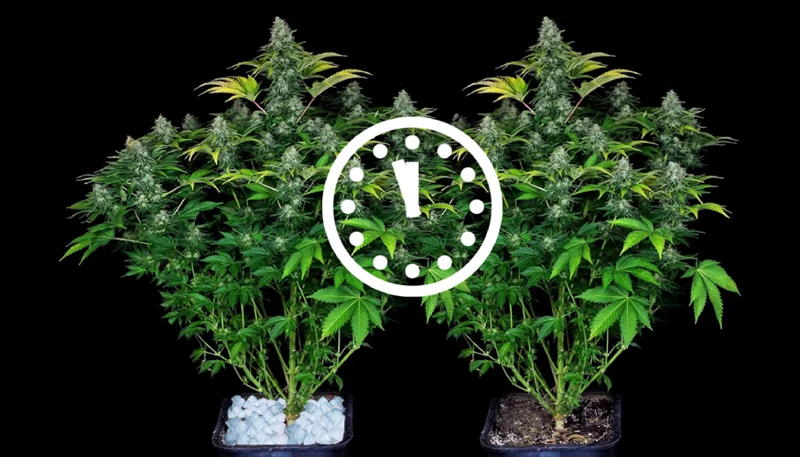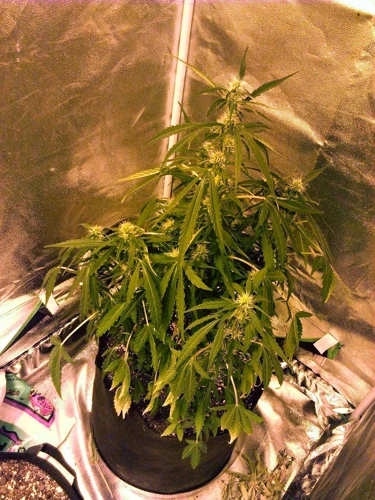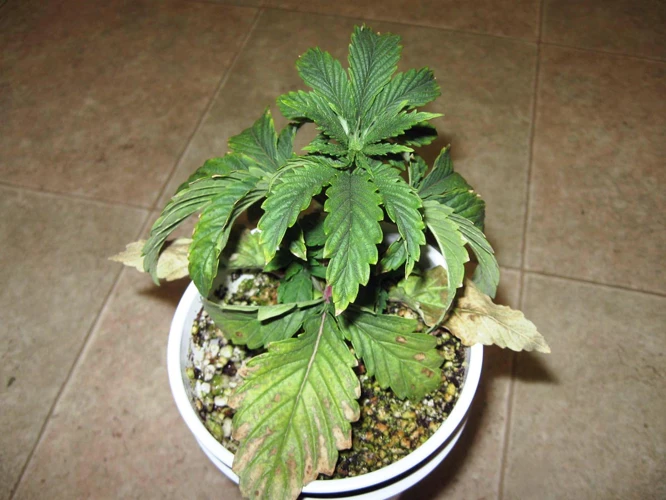
The Effects of Under-Watering on the Quality of Cannabis Buds
Introduction
Contents
Growing cannabis can be a rewarding and fulfilling experience, but it can also be quite challenging. One of the most common mistakes made by novice and experienced cannabis growers alike is under-watering. This occurs when a cannabis plant does not receive enough water to thrive and grow properly. Under-watering can have a serious impact on the quality of your cannabis buds, affecting their yield, potency, and overall quality. It is important to understand the impact of under-watering on your cannabis plants in order to prevent it from occurring and to ensure you produce the best possible harvest.
What is Under-watering?
Under-watering is a condition that occurs when the cannabis plants receive insufficient water to properly function. To grow and produce healthy buds, cannabis plants need the right amount of water regularly. When the plants are under-watered, they can’t adequately carry out essential physiological and biochemical processes, such as photosynthesis, respiration, and nutrient uptake.
Under-watering is a common problem in cannabis cultivation and can have severe effects on the quality and quantity of the yield. It is a critical issue to tackle for growers because the effects of under-watering can be irreversible after a certain period. It may also increase the susceptibility of cannabis plants to nutrient deficiencies, pests, and diseases.
To better understand under-watering and its impact on the quality of cannabis buds, it’s crucial to examine the signs of under-watering and ways to prevent it. Keep reading this article, as we will cover each aspect of under-watering in detail.
- Under-watering is a condition that occurs when the cannabis plants receive insufficient water to function.
- Cannabis plants need the right amount of water regularly to grow and produce healthy buds.
- Under-watering is a common problem in cannabis cultivation that can have severe effects on yield quality and quantity.
- Under-watering can increase the susceptibility of cannabis plants to nutrient deficiencies, pests, and diseases.
If you want to know more about the signs of under-watering, check out our previous article on this subject. It can help you identify and manage underwatered cannabis plants.
The Impact of Under-watering on Your Cannabis Buds
As every cannabis grower knows, proper nutrition and hydration are essential for the healthy growth and development of cannabis plants. Under-watering, a common issue that arises during the cultivation process, can negatively affect the quality of cannabis buds in a number of ways. Not providing your plants with the right amount of water can lead to reduced yields, low potency, nutrient deficiencies, and poor aroma and flavor. In this article, we will delve deeper into the impact of under-watering on your cannabis buds, and explore ways to prevent this issue from arising. If you are concerned about signs of under-watering in your cannabis plants, be sure to check out our in-depth guide on signs of under-watering to identify potential issues before they become a serious problem.
1. Reduced Yield and Potency
When cannabis plants are under-watered, it can lead to reduced yield and potency. This is because water is essential for plant development and the production of trichomes, which contain the cannabinoids and terpenes that give cannabis its effects and aroma.
Reduced Yield: Under-watered plants may produce smaller buds, fewer buds, or even no buds at all. This is because the plant is unable to develop properly without adequate water. Without water, the plant can’t transport nutrients throughout its system, which can stunt growth and lead to smaller yields.
Reduced Potency: Just like with yield, under-watered plants may have lower levels of THC and other cannabinoids. This is because the plant is not able to produce as many trichomes when it is under stress. Additionally, the terpenes that give cannabis its flavor and aroma may be less pronounced in under-watered plants.
It’s important to note that under-watering can have a more severe impact on younger plants compared to mature ones. Young plants are more vulnerable to environmental stress and can easily suffer long-term damage if not properly cared for.
To avoid reduced yield and potency due to under-watering, it is important to monitor your plants closely and provide adequate moisture as needed. For more information on caring for under-watered cannabis plants, check out our article on common symptoms and solutions.
2. Increased Risk of Nutrient Deficiencies
Under-watering is not just detrimental to the yield and potency of your cannabis plants, it can also increase the risk of nutrient deficiencies. When the plant lacks sufficient water, it struggles to absorb nutrients present in the soil. This can lead to nutritional imbalances and deficiencies, which can adversely affect the quality of your cannabis buds.
Here are some of the possible nutrient deficiencies that can occur due to under-watering:
- Iron (Fe) deficiency: Iron is essential for chlorophyll synthesis, and a lack of it can result in yellowing of the leaves.
- Magnesium (Mg) deficiency: Magnesium is a macronutrient required in large amounts by the plant. It plays a critical role in photosynthesis and the formation of chlorophyll. A deficiency in magnesium can lead to stunted growth and yellowing leaves.
- Calcium (Ca) deficiency: Calcium is critical for the proper development of the plant’s cell walls. Lack of calcium can result in stunted growth and weakened stems.
- Potassium (K) deficiency: Potassium is essential for the overall growth and health of the plant. A lack of potassium can lead to yellowing, necrosis (death of plant tissue), and reduced yields.
It is important to monitor your plants closely, particularly during the flowering stage when the demand for nutrients is at its highest. Proper watering practices can help ensure the plant is receiving adequate amounts of water and nutrients. Supplementing with fertilizer may be necessary to correct or prevent nutrient deficiencies. Always follow the recommended feeding instructions on the product label to avoid over- or under-fertilizing.
3. Poor Flavor and Aroma
When cannabis plants are under-watered, it has a negative impact not just on the yield and potency of the buds, but also on their flavor and aroma. If you have ever tried cannabis buds that lacked flavor and aroma and wondered why it tasted bland, under-watering might be the answer.
Poor flavor and aroma can be caused by a lack of water which reduces the plant’s ability to absorb essential nutrients. When nutrients are not adequately absorbed, it can lead to a lack of proper development of terpenes and flavonoids, which are responsible for the plant’s aroma and flavor.
Additionally, when the plant is under-watered, it can cause it to go into survival mode. The plant may focus its energy on essential functions rather than producing terpenes and flavonoids. As a result, the buds can lose their full potential for the unique flavors and aromas that consumers seek.
If the plant is underwatered for an extended period, it can cause the buds to become too dry, and its trichomes can also degrade, affecting the buds’ overall quality. Dry buds can be harsh and unpleasant to inhale, which can lead to an unpleasant overall experience.
It is crucial to make sure that your cannabis plants are appropriately watered and receive necessary nutrients to produce flavorful, aromatic buds.
Signs of Under-watering in Your Cannabis Plants
As a cannabis cultivator, it’s essential to keep a close eye on your plants and their overall health. One of the most common issues that can arise is under-watering, which can have a detrimental impact on your cannabis crop. But how can you tell if your plants are being under-watered? There are several telltale signs to look out for, all of which can indicate that your plants are not getting the hydration they need to thrive. From wilting leaves to dry soil and slow growth, these symptoms may vary, but they all signal that it’s time to take action. Let’s take a closer look at each one to help you identify and address under-watering issues in your cannabis plants.
1. Wilting Leaves
One of the most noticeable signs of under-watering in cannabis plants is wilting leaves. The leaves may appear droopy and lifeless, as if they’re lacking water. In severe cases, the leaves may even begin to curl up and become brittle.
To help you identify wilting leaves, here are some key characteristics to look for:
- The leaves will start to droop and look lifeless
- They may appear to be curling up or becoming brittle
- Eventually, they may dry up and fall off the plant
It’s important to note that wilting leaves can also be a sign of other problems, such as over-watering or nutrient deficiencies. However, if you notice wilting leaves in combination with dry soil and slow growth, it’s likely that under-watering is the culprit.
If you do notice wilting leaves in your cannabis plants, it’s important to take action quickly to prevent further damage. This may mean adjusting your watering schedule or increasing the amount of water you give your plants during each watering. Remember, cannabis plants need a consistent supply of water to thrive, and neglecting their needs can lead to stunted growth, reduced yields, and lower potency.
2. Dry Soil
One of the most evident signs of under-watering in your cannabis plants is dry soil. When your plants are not getting enough water, the soil in which they grow will start to dry out. This happens because the roots of your plants absorb water from the soil, and when they cannot get enough, they will start to dry out.
Dry soil is caused by a lack of water, and it can have a number of negative effects on your cannabis plants. First of all, when the soil is dry, it becomes difficult for your plants to absorb the nutrients that they need to grow and thrive. This can lead to nutrient deficiencies, which can affect the quality and potency of your buds.
Dry soil can also cause your plants to become stressed. When your plants are stressed, they are more susceptible to pests and diseases, which can further reduce the quality of your buds. Dry soil can cause your plants to wilt, curl up or even die.
To prevent dry soil, you need to make sure that you water your plants regularly and adequately. It’s also essential to monitor the moisture levels of the soil using a moisture meter. If you notice that the soil is dry, you should water your plants immediately. Be careful not to overwater them, as this can also have negative effects on your plants.
In addition to watering your plants properly, you can prevent dry soil by adjusting your feeding schedule. Make sure that your plants are getting the right amount of nutrients at the right time, and that you are not overfeeding or underfeeding them.
Dry soil is a clear indication that your cannabis plants are not getting enough water. It can lead to nutrient deficiencies, stress, and poor growth, as well as the reduction of bud quality and potency. You need to take proper measures to prevent it, including regular and consistent watering, monitoring the moisture levels of the soil, and adjusting your feeding schedule.
3. Slow Growth
Slow growth is another sign of under-watering in your cannabis plants. When your plants do not receive enough water, their growth rate will slow down significantly. This is because water is necessary for photosynthesis, which is the process of converting light into energy for plant growth. When there is not enough water, photosynthesis cannot happen at its full potential, and as a result, the plant growth slows down.
The following table summarizes the impact of slow growth due to under-watering on your cannabis plants:
| Effects of Slow Growth | Impact on Plants |
|---|---|
| Delayed flowering | Reduces bud production, and potentially lower THC levels due to the extended period of time spent in the vegetative phase. |
| Decreased nutrient uptake | Slow growth can lead to a lack of uptake of necessary nutrients, which can ultimately cause your cannabis plants to suffer from nutrient deficiencies. |
| Increased risk of pests and disease | Weak, slow-growing plants are more susceptible to pests and diseases, which can further damage the plant and stifle growth. |
It is vital to ensure that your cannabis plants are receiving adequate water to avoid these effects of slow growth due to under-watering. Remember to water your plants regularly and consistently and adjust your feeding schedule accordingly to maintain healthy growth.
How to Prevent Under-watering in Your Cannabis Plants
If you’re looking to avoid the negative effects of under-watering on your cannabis plants, it’s important to take preventative measures. By maintaining a consistent watering schedule and monitoring your plants’ moisture levels, you can help ensure that they receive the proper amount of hydration. In this section, we’ll explore some effective methods for preventing under-watering in your cannabis plants, including the use of moisture meters and adjusting your feeding schedule. Let’s dive in!
1. Use a Moisture Meter
To prevent under-watering in your cannabis plants, one of the most helpful tools you can use is a moisture meter. A moisture meter is a small device that you can insert into the soil around your cannabis plants to measure the moisture level.
The benefits of using a moisture meter:
| Benefit | Description |
| Accuracy | A moisture meter can provide a more accurate measurement of the soil moisture level than simply judging by the feel of the soil. |
| Time-saving | Using a moisture meter can save you time, as you can quickly determine whether your plants need watering or not. |
| Prevention of over-watering | By using a moisture meter, you can avoid over-watering your cannabis plants, which can also have negative effects on the quality of your buds. |
How to use a moisture meter:
Using a moisture meter is simple. First, insert the probe of the meter into the soil near your cannabis plant. Then, wait for the meter to provide a reading. The meter will usually have a gauge or a series of lights that indicate the moisture level in the soil. If the reading indicates that the soil is dry, you’ll know it’s time to water your plants.
By using a moisture meter, you can take the guesswork out of watering your cannabis plants and ensure that they receive the proper amount of moisture to grow healthy and produce high-quality buds.
2. Water Regularly and Consistently
One of the most effective ways to prevent under-watering in your cannabis plants is to water them regularly and consistently. It’s important to keep in mind that every plant is different and may have unique watering requirements. However, there are some general guidelines you can follow to ensure your plants stay properly hydrated.
1. Determine the Ideal Watering Schedule: When it comes to watering your cannabis plants, it’s important to find the right balance. Under-watering will lead to a lack of hydration and potential nutrient deficiencies, while over-watering can lead to root rot and other issues. As a general rule, most cannabis plants will require watering every 2-3 days. However, consider factors such as the size of the plant, the temperature, and humidity levels when determining the ideal watering schedule.
2. Use Good Quality Water: The type of water you use to hydrate your cannabis plants can also have an impact on their growth and overall health. Tap water may contain high levels of minerals and other contaminants that can lead to nutrient lockout and other problems. Invest in a good quality water filter or consider using distilled water for best results.
3. Monitor Soil Moisture: It’s important to keep an eye on the moisture levels of the soil to determine when your plants require water. Use a moisture meter or simply stick your finger into the soil to determine if it’s dry or moist. If the soil feels dry, it’s time to water your plants.
4. Water Slowly and Evenly: When watering your plants, it’s best to do so slowly and evenly to avoid runoff or uneven soil moisture. Use a watering can or a slow-drip irrigation system to ensure your plants get the right amount of water at the right pace.
5. Don’t Overwater: While it’s important to keep your cannabis plants hydrated, overwatering can be just as harmful as under-watering. Be mindful of the moisture levels of the soil and avoid watering your plants too frequently, especially if they have not yet fully dried out from the previous watering.
By following these tips for watering your cannabis plants, you can prevent under-watering and ensure your plants grow healthy, strong, and produce high-quality buds.
3. Adjust Feeding Schedule
As we’ve discussed earlier, under-watering can cause nutrient deficiencies in your cannabis plants. One way to prevent this is to adjust your feeding schedule. It’s important to provide your plants with the right amount of nutrients at the right time.
Here’s how you can adjust your feeding schedule:
| Issue | Solution |
|---|---|
| Nitrogen Deficiency | Adjust the amount of nitrogen in your nutrient solution, and use a fertilizer high in nitrogen during the vegetative stage of growth. |
| Phosphorus Deficiency | Increase the amount of phosphorus in your nutrient solution, and use a fertilizer high in phosphorus during the flowering stage of growth. |
| Potassium Deficiency | Add more potassium to your nutrient solution, and use a fertilizer high in potassium during the flowering stage of growth. |
| Calcium Deficiency | Make sure the pH of your nutrient solution is between 6.0 and 7.0, and use a calcium supplement. |
| Magnesium Deficiency | Make sure the pH of your nutrient solution is between 6.0 and 7.0, and use a magnesium supplement. |
By adjusting your feeding schedule, you can ensure that your cannabis plants are receiving the right amount of nutrients they need to grow, and prevent nutrient deficiencies that can be caused by under-watering. So, keep an eye out for any signs of deficiency and adjust your feeding schedule accordingly.
Conclusion
In conclusion, under-watering your cannabis plants can have a significant impact on the quality of your buds. The reduced yield and potency, increased risk of nutrient deficiencies, and poor flavor and aroma all contribute to a disappointing harvest. Therefore, it is crucial to identify the signs of under-watering in your plants and take preventative measures to avoid it.
One of the key indicators of under-watering is the wilting of leaves, which is often accompanied by dry soil and slow growth. To prevent under-watering, it is recommended to use a moisture meter to monitor soil moisture levels, water regularly and consistently, and adjust the feeding schedule accordingly.
By implementing these preventative measures, you can ensure that your cannabis plants receive the proper amount of water they need to thrive. This will result in a bountiful harvest of high-quality buds with robust flavor, aroma, and potency.
Overall, taking the time to prevent under-watering in your cannabis plants is a worthwhile investment that pays dividends in the form of a successful harvest. With the right care and attention, your buds will be the envy of all your friends and colleagues. So don’t let under-watering ruin your crop, take action today and reap the rewards tomorrow!
Frequently Asked Questions
1. What happens if I underwater my cannabis plants?
Under-watering cannabis plants can lead to reduced yield, potency, and poor flavor and aroma.
2. Can under-watering cause nutrient deficiencies in cannabis plants?
Yes, under-watering can lead to an increased risk of nutrient deficiencies in cannabis plants.
3. How do I know if my cannabis plants are under-watered?
Signs of under-watering include wilting leaves, dry soil, and slow growth.
4. Can over-watering have similar effects on cannabis plants?
Yes, over-watering can also lead to reduced yield and potency, as well as nutrient deficiencies and poor flavor and aroma.
5. Can I use tap water to water my cannabis plants?
It is recommended to use filtered or distilled water for your cannabis plants, as tap water may contain high levels of chlorine and minerals that can harm the plants.
6. How often should I water my cannabis plants?
The frequency of watering will depend on several factors such as the size of the plant and the environment, but generally, cannabis plants should be watered when the top inch of soil feels dry to the touch.
7. Can I use fertilizer to prevent under-watering?
No, fertilizer cannot prevent under-watering. Proper watering techniques and regular monitoring of soil moisture levels are the best ways to prevent under-watering.
8. Can underwatering cause damage to the roots of cannabis plants?
Yes, chronic under-watering can lead to root damage, which can further harm the plant’s growth and overall health.
9. Should I water my cannabis plants before or after feeding them?
It is recommended to water first and then wait for the soil to absorb the water before applying any nutrients or fertilizers.
10. How can I tell if I am over-watering or under-watering my cannabis plants?
You can tell if you are over-watering or under-watering your cannabis plants by monitoring the soil moisture levels and observing the plant’s behavior and growth patterns.





